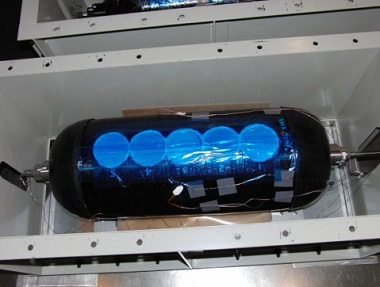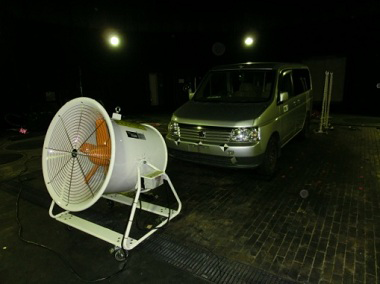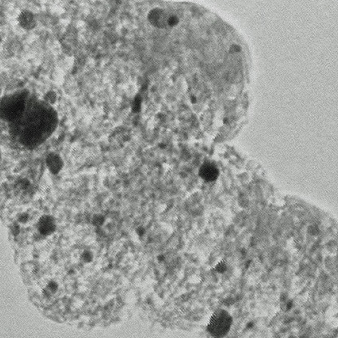Hydrogen and fuel cell
1) Safety assessment of compressed hydrogen tanks
JARI undertakes a variety of safety assessment tests on automotive compressed hydrogen tanks and their ancillaries, hoping to contribute to the establishment of both domestic and international standards for these containers and associated devices in the near future. In 2013 JARI started its usage environment load test on container units under the new Japanese standard. Our tests include the assessment of gas dispersion behavior, safety valve performance, nozzle icing at the filling of hydrogen, and filling protocols aimed to ensure a safe filling.

Chemical exposure test as part of usage environment load testing

Nozzle icing test
2) Safety assessment of hydrogen and fuel cell vehicles (FCVs)
JARI carries out various safety assessment tests related to the global harmonization of regulations for FCVs, and is engaged in research into FCV safety against road accidents in order to prepare for the wide use of FCVs. Additionally, we experiment on hydrogen leakage noise, how to judge the safety of burnt containers, post-accident methods of releasing hydrogen gas safely from the container, and how to disperse leaked hydrogen safely into the atmosphere, among other studies on hydrogen and FCVs.

Hydrogen leakage test using a wind blower
3) Fuel cell performance assessment
JARI investigates the effect of impurities contained in hydrogen fuel on power generation performance, on the deterioration of electrolytes, and on the poisoning of platinum catalysts. Based on the investigation results, Japan serves as the chair-country in the international discussion to draft a global hydrogen fuel quality standard. In addition we are working to develop a common durability evaluation protocol for membrane electrode assemblies in response to proposals from the Fuel Cell Commercialization Conference of Japan and the US Department of Energy, with a view to promoting the development of new materials for fuel cells. JARI are also developing an electrode catalyst observation technique using a transmission electron microscope under a simulated humid air condition for power generation in order to unravel the electrode catalyst deterioration mechanism.

Electrode catalyst observation under humid air conditions
